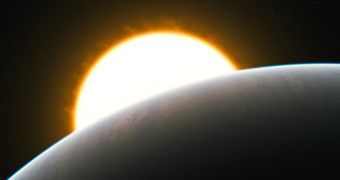The planet HD209458b, orbiting a sun in the constellation Pegasus, seems to be blasted with winds that top 7,000km per hour, astronauts recently discovered. The planet, situated some 150 light-years away, is a Jupiter-like world that orbits its star at one eighth the distance Mercury orbits the Sun. The storms that blast on its surface are caused by the small distance and the rotationally synched orbit around the star.
Being so close to its star, the exoplanet experiences temperatures of around 1000°C on its sun-facing side. Since the HD209458b has the same side to its star, the night side is much cooler, thus keeping the gases in the planet's atmosphere in a perpetual move. The planet has been discovered in 1999, and has become of great interest to researchers since, taking into account that it is transiting its parent star, causing a dip in the amount of detectable starlight.
The team of researchers presented their findings in Nature, reporting that the longitudinal winds on the planets surface reach about 2km/s. Ignas Snellen, based at Leiden University in the Netherlands, who led the team of astronomers, said that the study of poisonous carbon monoxide gas resulted in evidence of a 'super wind' blowing on the surface of HD209458b at speeds of 5,000 to 10,000km per hour, a recent article on ABC Science reports.
The researchers used the European Southern Observatory's Very Large Telescope (VLT) and its powerful CRIRES spectrograph for their study. They analyzed the starlight filtered through the planet's atmosphere at times when it passed in front of the star, while using the Doppler effect, or Doppler shift, to determine the exoplanet's mass.
“This is a real milestone in terms of characterizing these planets and being able to look into the details of what's happening in the atmospheres,” adds astronomer Mark Swain, with NASA's Jet Propulsion Laboratory in California. “We really don't have any planet in our solar system that is an analogue to this. Nothing's even close. One of the exciting reasons to study these 'hot Jupiters' is that we can look at what happens to a planetary atmosphere in an extreme environment.”

 14 DAY TRIAL //
14 DAY TRIAL //